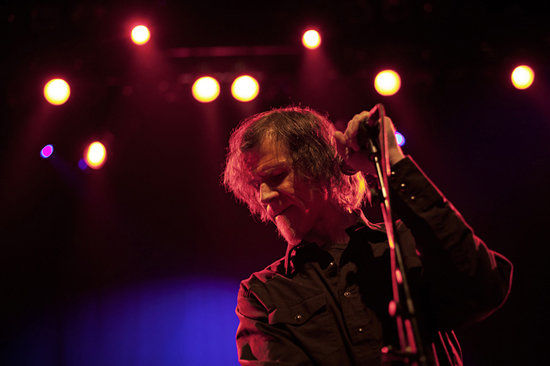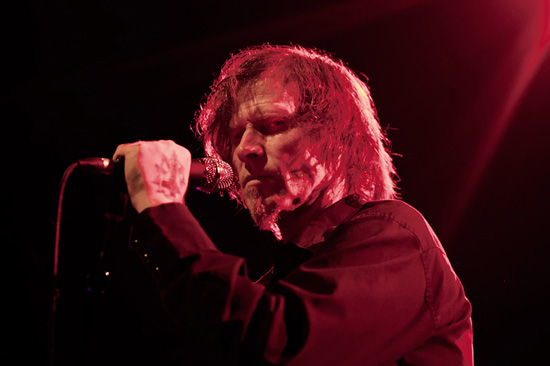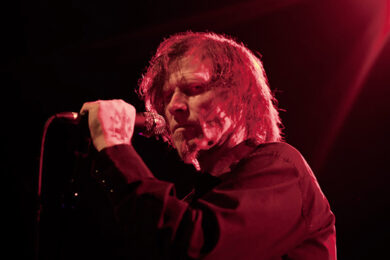Time was that seeing Mark Lanegan in concert was akin to being complicit in his
extra-curricular activities. The last time the Quietus encountered Lanegan in a solo
setting was back in 2004 at the Islington Academy. Shuffling on to the stage over
a half hour late, the black-clad, heavy-lidded singer seemed to take an age making
it to his spot. Wrapping one tattooed hand around his microphone and the other on
the stand, it might as well have been a crutch rather than a functional tool. In his
wake sloped out one of the most terrifying collection of musicians this writer has
ever witnessed. A mass of hair, piercings and body ink, it was difficult to escape the
feeling that they’d sooner sell their instruments for a fix rather than play them. But none of them held a light to Lanegan in the scary stakes. On the occasions he’d lift his head to sing, his frighteningly cadaverous visage revealed pinprick eyes set deeply in their sockets.
But through it all was That Voice, a seductive baritone growl revealing unpleasant truths and realities that sought out neither forgiveness nor acceptance. This was his truth, and with it came the kind of soul-baring that’s frequently imitated but rarely as sincere and honest as this.
It’s That Voice that’s seen Lanegan since take the kind of excursion that’s been in
short supply in the opening overs of the 21st century. A journeyman singer,
Lanegan has lent his remarkable vocal skills to any number of collaborators across the unlikeliest of genres. While James Lavelle’s UNKLE project made perfect sense for his talents, who would ever have put money on Lanegan working with Tim Simenon on a Bomb The Bass album? But it’s with Isobel Campbell that Lanegan truly hit a creative high outside of his comfort zone. A Lee Hazelwood and Nancy Sinatra for the new millennium, their initial live performances looked like nothing less than an awkward couple on their first date – she coyly standing behind her microphone while Lanegan’s shyness made him resemble a man waiting for the stage to open up and swallow him.
While the wait for solo material from Lanegan has finally been satisfied, in the shape of the remarkable Blues Funeral – undoubtedly one the musical highlights of this year so far, and one that sets a high water mark for his own career – the time spent waiting for him to finally commandeer a stage on his own terms has been almost painful. With the Shepherd’s Bush Empire packed to bursting, the level of expectation easily surpasses that of a giddy child waking hours before its parents on Christmas Day.
Now sober, Lanegan may no longer shuffle on stage but neither does he stroll. Once again, the inked fingers of his left hand wrap themselves around his microphone while the other grips the stand – but this is no longer a means of support. As his fingers tap out the rhythm of crunching opener ‘The Gravedigger’s Song’, it’s more than obvious that Mark Lanegan is standing on his own two feet. Where once his head was stooped and bowed and avoiding the gaze of his constituency, now he looks around him as if sniffing the air to breathe in the adulation. This is about as close to interaction as the audience will get tonight, though on two separate occasions he actually thanks them as well as taking time out to offer praise to his band.

Speaking to The Quietus at the tail end of last year, Lanegan admitted to a lack of confidence as a performer, intimating that this was a necessary evil for the path that
he’s chosen to follow. There are hints that this still might be the case. His sense of
impatience between numbers is palpable as his gaze turns from the audience to an
occasional glower at drummer Jean-Philippe De Gheest as he waits for the count-in. But whatever reservations Lanegan has about himself as a performer, they are soon cast into the ether as his commanding voice takes centre stage once again.
Few are the frontmen that rarely move on stage. Liam Gallagher – once
comprehensively blown off stage by Lanegan’s former alma mater Screaming Trees at the Jones Beach Amphitheatre in Long Island back in ’96 – may like to think he’s a minimalist performer but compared to Mark Lanegan he may as well be Iggy Pop. Such an approach would prove to be the undoing of lesser artists but here Lanegan, like some kind of pillar carved from the toughest rock, offers an irresistible yet impenetrable enigma.
Much credit for tonight’s success should also be laid at the feet of Lanegan’s young
band. Guitarist Steven Janssens – a quiffed figure resplendent in a dark boot-cut
country and western suit – is a musician whose skills with his instrument see him
move from the squalls of ‘Riot In My House’ to the delicate and delayed arpeggios
of ‘Haborview Hospital’ with a deft and almost casual ease. On the other side of
stage sits Aldo Struyf, whose role as Minister Of Sinister Noises entails moving from
keyboards to ominous string scrapings and back again, all underpinned by Frederic Jacques’ solid low-end rumble.
With the set understandably weighted in favour of his current material – the dance-
noir of ‘Ode To Sad Disco’ and the metronomic drive of ‘Quiver Syndrome’ are
particular highlights – Lanegan makes frequent nods to the past. A stark reading
of ‘Resurrection Song’ follows the haunting ‘One Way Street’ but perhaps the biggest surprise of the night is Lanegan exhuming Screaming Trees’ ‘Crawlspace’ from last year’s posthumous Last Words: The Final Recordings.
It wasn’t all that long ago that Mark Lanegan seemed destined to join the long line
of artists whose light was cruelly snuffed out long before their time. The history of
music is littered with a trail of unanswered questions and unfulfilled potential and
that Lanegan could have added to this would have been a tragedy on both a personal and artistic level. But, as evidenced by Blues Funeral and a compelling performance based on authority and raw talent, Lanegan is providing as much a tantalising future as he is an incredible past.
Photos / Andrew Novell



